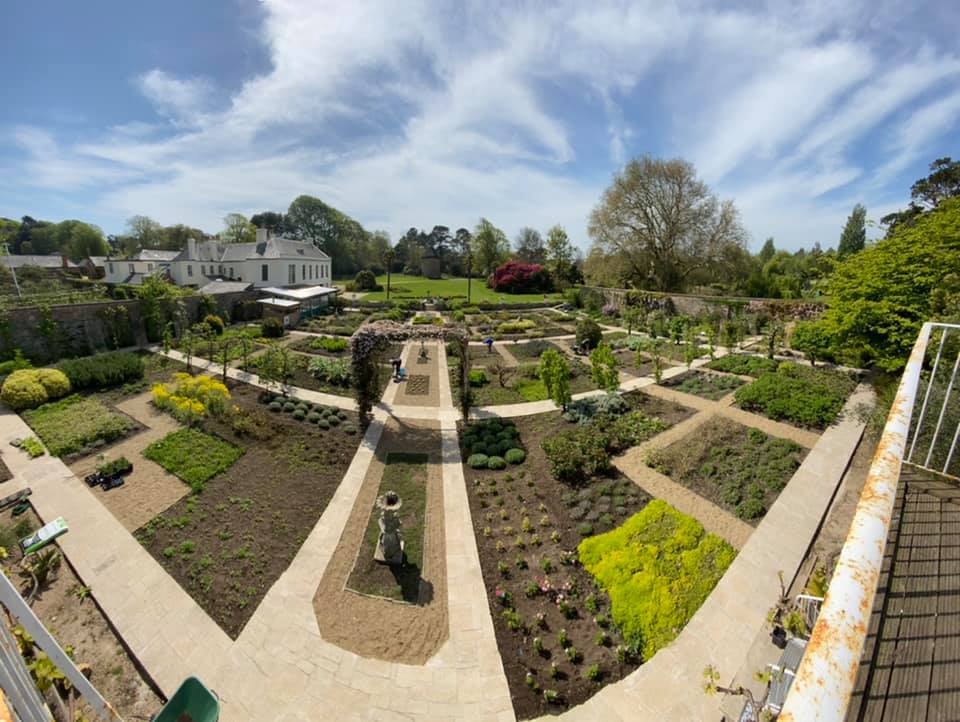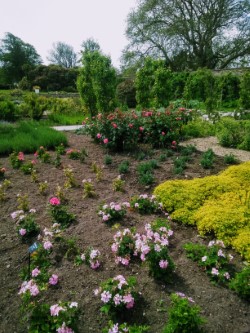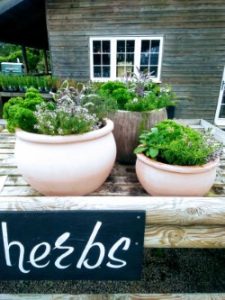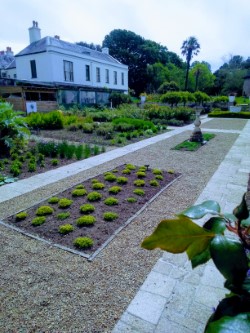
SALLY ROBERTS works in the herb garden at Samarès Manor. In the first of a series of articles, she writes about the garden and about the herbs that provide her with both her work and her specialist interest
THE herbs at Samarès happily share the walled garden with the beautiful collection of roses and lavenders, and this year it has never looked better.

During the winter months new paths were laid throughout, and although the layout remains the same, it is looking brand new and bursting with life – almost as if the plants themselves are proud of their new foundation. The gardening team can also feel proud, they have tended it beautifully, and it shows.
The herbs are divided into four sections – the culinary herbs, herbs for dyeing cloth, fragrant herbs, and last, but by no means least, the medicinal herbs. Herbs have been used for thousands of years as food and medicine, for dyeing and creating all kinds of lotions and potions to soothe our souls, enhance our health and beauty, to honour and celebrate the earth and the seasons.
For the last two years, I have been delighted to give the daily herb talk in the garden during the summer months. All kinds of people come along, from complete novices to the very experienced, and there is always pleasure to be found talking about the herbs, tasting them, smelling them, and just being amongst them. I have always believed that growing and using herbs is one of the healthiest and most nourishing things anyone can do – and now, more than ever, we are being made aware of the need of our physical and emotional health in a whole new way. What truly nourishes us?
At the time of writing, we have had a few weeks of to think about this. Lockdown has given many people the time to discover or reconnect with their cooking, their gardens, their creativity, and what really matters to them. I have no idea whether I will be able to give herb talks here later this summer, but I do suggest that this is a perfect time to enjoy growing herbs and really using them.
IMMUNE BOOSTING HERBS
Naturally, everyone wants to know at the moment which herbs could help build up their immune system. The good news is that most herbs will benefit our health in some way or other. With some herbs it is primarily their nutrient content, for example, parsley – parsley is packed with vitamins, including vitamin C, A, B12 and K, and is a source of iron, potassium and magnesium, so add lots of finely chopped fresh parsley to your dishes each day.
With other herbs we are used to using in our cooking, it isn’t just their flavour they can be used for, but their action on our bodily functions – our digestive system, respiratory system, circulatory system and so on.
We can drink herbal teas and infusions as well as cooking with them; we can inhale the vapours of them infused in hot water to aid our breathing, and relax or stimulate our minds. Many herbs are strongly antiseptic and anti-microbial, and have been used throughout the ages to disinfect the air in our homes, clean wounds, clear headaches and sinuses.
I tend to focus primarily on the culinary herbs during my talks, as we know they are safe for anyone to use. Quite a number of the herbs in the medicinal section should only be used under the supervision of a qualified, professional herbalist, as they are powerful medicines indeed, and could easily contra – indicate prescription drugs you are using. Since I am unable to do the herb talks at the moment, we are creating some pots of inspiration for you with ideas of herb collections to grow for different reasons. If you follow The Botanical Gardens of Samarès Facebook page, you will have news of these herb pots, and you may even catch a video of me talking about them.
This information will also be available on the RURAL magazine website. We also have a wonderful selection of herbs for sale at our plant centre, so come and enjoy creating your own collections.

THE SCARBOROUGH FAIR COLLECTION
‘Are you going to Scarborough Fair?
Parsley, Sage, Rosemary and Thyme….’
THE old folk song reminds us that herbs have been used for hundreds of years – in fact thousands of years – not only to flavour our food, but to aid our health in many ways
Indeed, it always interests me how the symbolism of herbs strikes a chord somewhere in most people’s hearts – in this case, parsley for comfort or to remove bitterness, sage for strength, thyme for courage, rosemary for love and remembrance.
These herbs have been chosen as the most basic collection – how could any cook be without them? They are also extremely supportive to our health and immune system. There could be no better time than now to begin to truly enjoy the benefits of growing your own herbs and really using them. The pleasure and fulfilment goes way beyond simply making your food taste better. Below are some simple ideas for each of these herbs for you to begin with.
PARSLEY
‘This beautiful herb, the emblem of joy and fertility’ – Mrs Isabella Mary Beeton
Parsley was actually revered by the ancient Greeks as a sacred herb – flat leaf parsley is the most versatile, curly leaf is slightly more bitter and textured. It is one of the most useful herbs in the kitchen, with its clean, green flavour.
It is super rich in vitamins, including Vitamin A, B12, C and K, as well as flavonoids with anti-oxidant effects, and a rich source of iron, protein, potassium and magnesium. It is so nutritious it is sad that for so many years many people have seen it merely as a garnish, and left it on the side of the plate. What a waste!
Today it has increasing prominence, used liberally in salsa verde, tabbouleh, gremolata, and chimichurri. Traditionally, English cooks have made parsley sauce to serve with fish or ham. It can, of course, be added to any fruit/vegetable juices you make for extra nutrition. Parsley butter is a delicious addition to many meats, fish and vegetables.
Medicinally, it can be drunk as a tea for water retention as it is a mild diuretic, stimulates the digestion, and eases wind in the digestive tract. It also helps to improve iron intake and absorption.
SAGE
‘He that would live for aye,
Must eat sage in May’‘ – old English proverb
The name derives from the Latin ‘salvare’ to save, and sage was also sacred to the Greeks and Romans, considered a preserver and giver of life. It was, and is, one of the most precious medicinal herbs. Since ancient times, this powerful antiseptic was used to keep teeth clean – it was actually used during the Occupation for this – and relieve sore gums. Best known for treating colds and sore throats, a tea with honey and a slice of orange or lemon is extremely effective for this. Many women find it soothes menopausal symptoms, especially hot flushes and night sweats.
Sage also aids digestion, which is why it is often cooked with fatty meats like pork, goose and duck, also to flavour sausages and stuffing for pork or poultry. Italians often fry it lightly in butter to pour over pasta, cook it with polenta or deep fry it as a crisp garnish. The ancient Provencal recipe ‘aigo bouido’ is used as a remedy for hangovers and exhaustion, and is simply garlic, sage and a little olive oil boiled for 15 minutes in a pan of water, strain, then gently pour over a fresh egg yolk. Stir until the yolk thickens the infused water.
ROSEMARY
‘There’s rosemary, that’s for remembrance’ – William Shakespeare
Rosemary, literally meaning ‘dew of the sea’, was thrown into graves to signify remembrance, and also symbolizes friendship and fidelity, often used in wedding decorations. A strong antiseptic, it was strewn on floors or burnt in sick rooms to disinfect or freshen the air. Once popular carried in posies to guard against infectious diseases.
A stimulating plant, it can uplift the mood, sharpen and strengthen the mind, helping nervous exhaustion and anxiety. Drink it as a tea, or simmer in a pan of hot water to clear the air.
Another herb that aids digestion, often cooked with roast lamb, and delicious scattered over sautéed potatoes, or roasted vegetables, especially pumpkin or squash.
Rosemary infused oil is marvellous for massaging aching joints, and especially helpful for headaches with a stiff neck and shoulders. It has been used through the centuries as a rinse to condition the hair, and as a breath freshener.
THYME
‘I know a bank where the wild thyme blows’ – William Shakespeare
In the Middle Ages, thyme was tucked under pillows to ensure a good night’s sleep, keeping nightmares away. Women gave their knights a sprig to put in their clothing or armour to fill them with courage. Powerfully antiseptic, it was also used as a strewing herb in times of plague throughout history.
It is one of its principal constituents, thymol, that is so effective, and today it is used in cough medicines and lozenges, mouthwashes and ointments. Like sage, it makes a wonderful infusion for sore throats to drink or gargle with. Anti-microbial, it also acts as an expectorant.
Of course, no cook would be without thyme – an essential ingredient in a bouquet garni along with parsley and bay. Tie with string and add to casseroles, the flavours withstand long, slow cooking. Wonderful with most roasted meats or vegetables, and classic in stuffings and marinades.
Za’atar is the Arabic name for wild thyme, and we know this now as a popular seasoning made with thyme, salt, sesame seeds and sumac to sprinkle over our dishes, or simply as a dip alongside olive oil and flatbreads. Delicious.
LEMON THYME
Once you have cooked with lemon thyme, it’s hard to be without it – the combination of the lemon flavour with the thyme creates a softer, gentler flavour. If you find a thyme tea or infusion too strong, use lemon thyme.
It is perfect tucked under the skin of a chicken for roasting, and is subtle enough to work with fish. Lemon thyme also works in sweet recipes – biscuits, creamy desserts and cakes. It gives an earthy, herby flavour to homemade lemonade, and not to be forgotten in cocktails either……..
Try a simple vinaigrette with it – whisk 2 tablespoons of lemon juice with 4 tablespoons of olive oil, 1 tablespoon of lemon thyme leaves, salt and pepper. Serve not just on salad, but with grilled fish or chicken, new potatoes, green beans, and my favourite – with carrots.
It also contains the precious thymol, so has an antiseptic quality as does common thyme.





